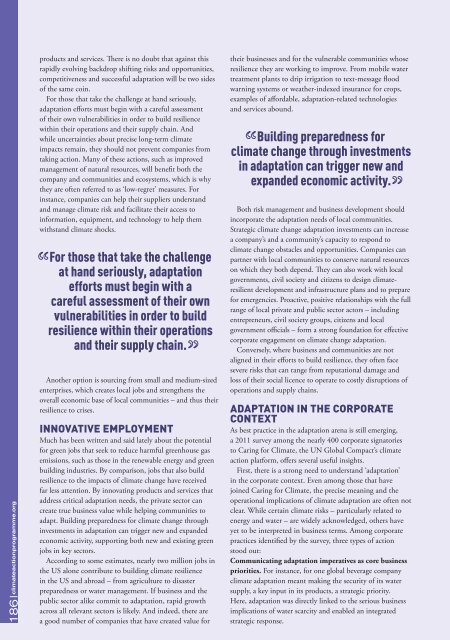Climate Action 2011-2012
You also want an ePaper? Increase the reach of your titles
YUMPU automatically turns print PDFs into web optimized ePapers that Google loves.
CA<strong>2011</strong> GlobalCompact_1.pdf<br />
186 climateactionprogramme.org<br />
products and services. There is no doubt that against this<br />
rapidly evolving backdrop shifting risks and opportunities,<br />
competitiveness and successful adaptation will be two sides<br />
of the same coin.<br />
For those that take the challenge at hand seriously,<br />
adaptation efforts must begin with a careful assessment<br />
of their own vulnerabilities in order to build resilience<br />
within their operations and their supply chain. And<br />
while uncertainties about precise long-term climate<br />
impacts remain, they should not prevent companies from<br />
taking action. Many of these actions, such as improved<br />
management of natural resources, will benefit both the<br />
company and communities and ecosystems, which is why<br />
they are often referred to as ‘low-regret’ measures. For<br />
instance, companies can help their suppliers understand<br />
and manage climate risk and facilitate their access to<br />
information, equipment, and technology to help them<br />
withstand climate shocks.<br />
For those that take the challenge<br />
at hand seriously, adaptation<br />
efforts must begin with a<br />
careful assessment of their own<br />
vulnerabilities in order to build<br />
resilience within their operations<br />
and their supply chain.<br />
Another option is sourcing from small and medium-sized<br />
enterprises, which creates local jobs and strengthens the<br />
overall economic base of local communities – and thus their<br />
resilience to crises.<br />
innovAtive employment<br />
Much has been written and said lately about the potential<br />
for green jobs that seek to reduce harmful greenhouse gas<br />
emissions, such as those in the renewable energy and green<br />
building industries. By comparison, jobs that also build<br />
resilience to the impacts of climate change have received<br />
far less attention. By innovating products and services that<br />
address critical adaptation needs, the private sector can<br />
create true business value while helping communities to<br />
adapt. Building preparedness for climate change through<br />
investments in adaptation can trigger new and expanded<br />
economic activity, supporting both new and existing green<br />
jobs in key sectors.<br />
According to some estimates, nearly two million jobs in<br />
the US alone contribute to building climate resilience<br />
in the US and abroad – from agriculture to disaster<br />
preparedness or water management. If business and the<br />
public sector alike commit to adaptation, rapid growth<br />
across all relevant sectors is likely. And indeed, there are<br />
a good number of companies that have created value for<br />
their businesses and for the vulnerable communities whose<br />
resilience they are working to improve. From mobile water<br />
treatment plants to drip irrigation to text-message flood<br />
warning systems or weather-indexed insurance for crops,<br />
examples of affordable, adaptation-related technologies<br />
and services abound.<br />
Building preparedness for<br />
climate change through investments<br />
in adaptation can trigger new and<br />
expanded economic activity.<br />
Both risk management and business development should<br />
incorporate the adaptation needs of local communities.<br />
Strategic climate change adaptation investments can increase<br />
a company’s and a community’s capacity to respond to<br />
climate change obstacles and opportunities. Companies can<br />
partner with local communities to conserve natural resources<br />
on which they both depend. They can also work with local<br />
governments, civil society and citizens to design climateresilient<br />
development and infrastructure plans and to prepare<br />
for emergencies. Proactive, positive relationships with the full<br />
range of local private and public sector actors – including<br />
entrepreneurs, civil society groups, citizens and local<br />
government officials – form a strong foundation for effective<br />
corporate engagement on climate change adaptation.<br />
Conversely, where business and communities are not<br />
aligned in their efforts to build resilience, they often face<br />
severe risks that can range from reputational damage and<br />
loss of their social licence to operate to costly disruptions of<br />
operations and supply chains.<br />
AdAptAtion in the corporAte<br />
context<br />
As best practice in the adaptation arena is still emerging,<br />
a <strong>2011</strong> survey among the nearly 400 corporate signatories<br />
to Caring for <strong>Climate</strong>, the UN Global Compact’s climate<br />
action platform, offers several useful insights.<br />
First, there is a strong need to understand ‘adaptation’<br />
in the corporate context. Even among those that have<br />
joined Caring for <strong>Climate</strong>, the precise meaning and the<br />
operational implications of climate adaptation are often not<br />
clear. While certain climate risks – particularly related to<br />
energy and water – are widely acknowledged, others have<br />
yet to be interpreted in business terms. Among corporate<br />
practices identified by the survey, three types of action<br />
stood out:<br />
Communicating adaptation imperatives as core business<br />
priorities. For instance, for one global beverage company<br />
climate adaptation meant making the security of its water<br />
supply, a key input in its products, a strategic priority.<br />
Here, adaptation was directly linked to the serious business<br />
implications of water scarcity and enabled an integrated<br />
strategic response.












